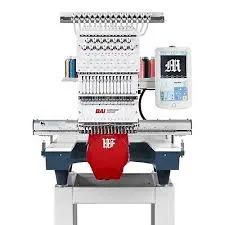12 月 . 03, 2024 17:13 Back to list
Exploring the Benefits and Features of Digital Embroidery Machines for Creative Projects
The Evolution and Impact of Digital Embroidery Machines
Digital embroidery machines have revolutionized the textile and fashion industries, merging traditional craftsmanship with cutting-edge technology. This transition has not only enhanced the production process but has also opened up a realm of possibilities for designers, businesses, and hobbyists alike. As we delve into the world of digital embroidery machines, we will explore their evolution, advantages, and future potential.
Historical Context
Embroidery has a rich history that dates back thousands of years, with handmade techniques passed down through generations. The introduction of mechanization in the 19th century marked a significant milestone, allowing larger-scale production of embroidered fabrics. However, these early machines were limited in their capabilities, often producing simplistic designs. It wasn't until the advent of digital technology in the late 20th century that embroidery began to enter a new era.
The introduction of Computer-Aided Design (CAD) software transformed how designs were created. Designers could now create intricate patterns using digital tools, which were then translated to embroidery machines through digitizing software. This breakthrough paved the way for the development of sophisticated digital embroidery machines that could execute complex designs with precision and speed.
Features of Digital Embroidery Machines
Modern digital embroidery machines come equipped with a variety of features that make them indispensable for both large-scale manufacturers and small business owners
. One of the most prominent features is the ability to store and recall designs digitally. This function not only saves time but also minimizes errors associated with manual design transfer.Additionally, advanced machines offer a range of stitch styles, thread colors, and decoration techniques, allowing for customization and creativity. With user-friendly interfaces and touchscreen controls, even those without extensive technical expertise can easily operate these machines. Some models are equipped with Wi-Fi capabilities, enabling remote design uploads and updates.
Advantages of Digital Embroidery Machines
digital embroidery machine

1. Efficiency and Speed Digital embroidery machines drastically reduce the time needed to produce embroidered items. What once took hours of manual labor can now be completed in a fraction of the time, allowing businesses to improve their output and meet customer demands more effectively.
2. Consistency and Quality One of the most significant benefits of digital machines is their ability to produce consistent results. Unlike human hands, which can tire and make mistakes, digital machines maintain a high level of accuracy throughout the production process. This consistency is crucial for businesses aiming to maintain their reputation for quality.
3. Design Flexibility The ability to easily create and modify designs makes these machines incredibly flexible. Designers can experiment with various patterns and styles without incurring significant costs or time delays. This flexibility enables businesses to quickly adapt to changing market trends and customer preferences.
4. Accessibility The rise of digital embroidery machines has made this form of artistry accessible to a broader audience. Small businesses and individual entrepreneurs can invest in these machines, allowing them to create custom products and tap into niche markets. Additionally, hobbyists can explore their creativity without the constraints of manual labor.
The Future of Digital Embroidery Machines
As technology continues to advance, the future of digital embroidery machines looks promising. Innovations such as artificial intelligence and machine learning are beginning to be integrated into these devices, enabling them to analyze patterns, suggest improvements, and even learn from past designs. This could lead to even greater efficiencies and capabilities in the realm of embroidery.
Moreover, with the growing interest in sustainable and eco-friendly practices, manufacturers are developing machines that minimize waste and optimize material usage. The integration of these practices will ensure that digital embroidery remains a viable option for environmentally conscious consumers.
Conclusion
Digital embroidery machines represent a significant leap forward in the art of embroidery. By combining traditional techniques with modern technology, they provide unmatched efficiency, quality, and accessibility. As we look to the future, the potential for innovation within this field is vast, promising to further enhance the creativity and productivity of those who embrace it. As the industry evolves, digital embroidery machines will undoubtedly play a crucial role in shaping the future of textile design and production.
-
Professional Embroidery Machines High-Speed Industrial Solutions & Custom Designs
NewsMay.30,2025
-
Premium 2-Head Embroidery Machines Reliable Manufacturers & Suppliers
NewsMay.30,2025
-
12 Head Embroidery Machines High-Speed & Precision Stitching
NewsMay.30,2025
-
Premium Tshirt Embroidery Machines High-Speed & Precision Stitching
NewsMay.29,2025
-
6 Head Embroidery Machines High-Speed Multi-Head Designs & Suppliers
NewsMay.29,2025
-
Commercial Automatic 2 Heads Embroidery Machine Caps and shirts 12 15 Needles Two Heads Computerized Embroidery Machine
NewsMar.07,2025

Copyright © 2025 Xingtai Pufa Trading Co., Ltd All Rights Reserved. Sitemap | Privacy Policy
